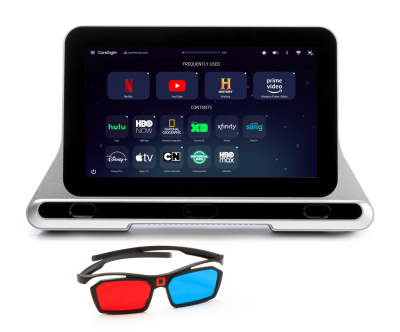Amblyopia, or lazy eye, is often treated at a young age with the use of eye patches, worn over the stronger eye for several hours a day to help stimulate the eye with poorer vision.
But the Israel-based NovaSight has scoped out a new, fully digital approach that may be just as effective—without the discomfort and self-esteem issues that have been linked to wearing eye patches for long periods of time.
The company’s CureSight technology has now been cleared by the FDA, NovaSight announced this week, allowing the eye-tracking device to be used by children in the U.S. to treat their reduced vision.
It consists of a pair of red-blue treatment glasses that users wear while viewing any streamed video content of their choice on a tablet. Relying on calculations from algorithms and eye-tracking technology, the system blurs the center of vision in the images being broadcast to the user’s stronger eye, encouraging the other eye to focus and work in tandem with the stronger eye to fill out the details of each image.
CureSight is meant to be used at home, while automatically sending progress and compliance reports to each user’s healthcare providers through a connected web portal.

The FDA nod came after NovaSight submitted study results showing that the CureSight system produced similar results in treating amblyopia compared to the standard eye-patching approach.
The clinical trial assigned 103 patients between the ages of 4 and 9 to use either CureSight or eye patches. Not only did CureSight meet its primary endpoint of achieving treatment results that were “non-inferior” to eye patching, but the CureSight group also saw a greater improvement in the best corrected visual acuity (BCVA) of their amblyopic eyes than those in the patching group after 16 weeks of treatment. Nearly 80% of CureSight patients who reached the 16-week point saw their BCVA score improve by at least two lines on an eye chart, compared to just over 60% of those in the eye patch group.
Meanwhile, the system also scored an average adherence rate of 93% over the four-month study period, and more than 90% of the patients’ parents said they were likely to choose CureSight over eye patches if given the option.
“The potential for CureSight to be a standard-of-care-changing technology has increased exponentially with this milestone FDA clearance,” said Ran Yam, NovaSight’s co-founder and CEO. “The standard-of-care eye-patching treatment, which hasn’t changed for centuries, can be effective if the child adheres to the treatment. However, self-esteem issues and discomfort can limit compliance to below 50%, and this results in patients suffering from reduced vision in one eye, limited coordination skills and impaired depth perception in adulthood.”
Beyond CureSight, NovaSight is developing a handful of other digital treatments to improve pediatric vision care. Its CE-marked EyeSwift device uses eye-tracking technology to quickly screen for amblyopia, myopia and more, while the TrackSight system is designed to monitor eye health and prevent myopia when used during a child’s typical screen time.